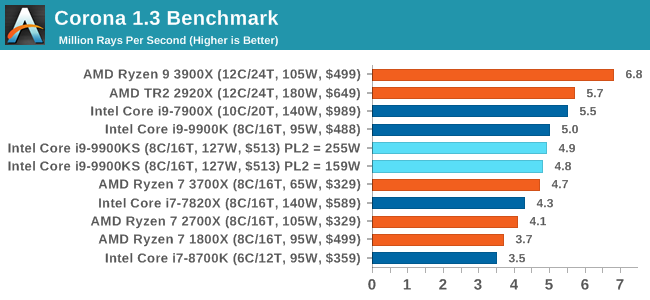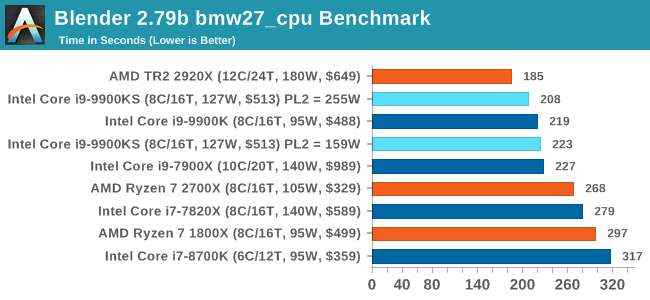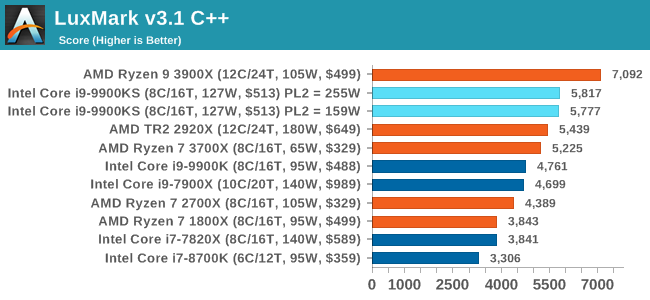The Intel Core i9-9900KS Review: The 5 GHz Consumer Special
by Dr. Ian Cutress on October 31, 2019 10:45 AM ESTCPU Performance: Rendering Tests
Rendering is often a key target for processor workloads, lending itself to a professional environment. It comes in different formats as well, from 3D rendering through rasterization, such as games, or by ray tracing, and invokes the ability of the software to manage meshes, textures, collisions, aliasing, physics (in animations), and discarding unnecessary work. Most renderers offer CPU code paths, while a few use GPUs and select environments use FPGAs or dedicated ASICs. For big studios however, CPUs are still the hardware of choice.
All of our benchmark results can also be found in our benchmark engine, Bench.
Corona 1.3: Performance Render
An advanced performance based renderer for software such as 3ds Max and Cinema 4D, the Corona benchmark renders a generated scene as a standard under its 1.3 software version. Normally the GUI implementation of the benchmark shows the scene being built, and allows the user to upload the result as a ‘time to complete’.
We got in contact with the developer who gave us a command line version of the benchmark that does a direct output of results. Rather than reporting time, we report the average number of rays per second across six runs, as the performance scaling of a result per unit time is typically visually easier to understand.
The Corona benchmark website can be found at https://corona-renderer.com/benchmark

Interestingly both 9900KS settings performed slightly worse than the 9900K here, which you wouldn't expect given the all-core turbo being higher. It would appear that there is something else the bottleneck in this test.
Blender 2.79b: 3D Creation Suite
A high profile rendering tool, Blender is open-source allowing for massive amounts of configurability, and is used by a number of high-profile animation studios worldwide. The organization recently released a Blender benchmark package, a couple of weeks after we had narrowed our Blender test for our new suite, however their test can take over an hour. For our results, we run one of the sub-tests in that suite through the command line - a standard ‘bmw27’ scene in CPU only mode, and measure the time to complete the render.
Blender can be downloaded at https://www.blender.org/download/

All the 9900 parts and settings perform roughly the same with one another, however the PL2 255W setting on the 9900KS does allow it to get a small ~5% advantage over the standard 9900K.
LuxMark v3.1: LuxRender via Different Code Paths
As stated at the top, there are many different ways to process rendering data: CPU, GPU, Accelerator, and others. On top of that, there are many frameworks and APIs in which to program, depending on how the software will be used. LuxMark, a benchmark developed using the LuxRender engine, offers several different scenes and APIs.
In our test, we run the simple ‘Ball’ scene on both the C++ and OpenCL code paths, but in CPU mode. This scene starts with a rough render and slowly improves the quality over two minutes, giving a final result in what is essentially an average ‘kilorays per second’.

Both 9900KS settings perform equally well here, and a sizeable jump over the standard 9900K.
POV-Ray 3.7.1: Ray Tracing
The Persistence of Vision ray tracing engine is another well-known benchmarking tool, which was in a state of relative hibernation until AMD released its Zen processors, to which suddenly both Intel and AMD were submitting code to the main branch of the open source project. For our test, we use the built-in benchmark for all-cores, called from the command line.
POV-Ray can be downloaded from http://www.povray.org/

One of the biggest differences between the two power settings is in POV-Ray, with a marked frequency difference. In fact, the 159W setting on the 9900KS puts it below our standard settings for the 9900K, which likely had an big default turbo budget on the board it was on at the time.











235 Comments
View All Comments
prophet001 - Monday, November 4, 2019 - link
I mainly play WoW and this would do a much better job than a 3900.Why does that tilt people?
Qasar - Monday, November 4, 2019 - link
you sure about that ??? i have 2 comps, both with a asus strix 1060 gaming OC, one with a 5930k, the other with an FX 8350, both max eye candy less AA ( 4x ) and AF ( 4x as well i think ) , and get about the same FPS. the 3900 will prob use less power over this.MDD1963 - Thursday, November 7, 2019 - link
I'm surprised an FX8350 can saturate a GTX1060, but, you maxing out the details and quality is the only reason the FX keeps up...; it's like saying the i5-8400 matches the 9900KS at 4k with a GTX1070. (Of course it does)eek2121 - Friday, November 1, 2019 - link
bwahahah, have you looked at the benchmarks? Enjoy your 3-5 extra FPS in gaming. ;)Korguz - Friday, November 1, 2019 - link
and the added power usage....Chaitanya - Thursday, October 31, 2019 - link
Also comes with only 1 year warranty. By special it really should mean mentally defective edition.amnesia0287 - Friday, November 8, 2019 - link
How many people ever actually use the warranty anyway lol.Samus - Friday, November 1, 2019 - link
Because it's drop-in compatible with the poor sap who isn't getting enough from the cheap Walmart i3 gaming PC they overpaid for.Unfortunately AMD just doesn't have the presence in retail to gloat that. Ironic, because traditionally AMD has had a superior upgrade path, keeping sockets longer and (provided motherboard vendors support their boards) new microcode support via BIOS updates.
josiasmat - Thursday, October 31, 2019 - link
I find it funny that in the past Intel CPUs were praised for their power efficiency over AMD ones. Now that AMD has a 65W CPU that is almost as fast as the reviewed CPU, it doesn't matter at all...Sivar - Thursday, October 31, 2019 - link
Indeed, the 7nm process is clearly a win here. That said, total platform power with Intel (9900KS excluded!) still tends to be lower very similar or even lower, in part due to the rather power-hungry 14nm AMD 570x chipset.470x-based AMD systems still win in most cases, but not by an extremely large amount.